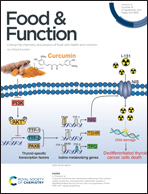In vitro fecal fermentation profiles and microbiota responses of pulse cell wall polysaccharides: enterotype effect
Abstract
The gut microbiota community of individuals is predominated by diverse fiber-utilizing bacteria, and might have distinct fermentation outcomes for a given dietary substrate. In this research, we isolated pea cell walls (PCWs) from cotyledon seeds, and performed the in vitro fecal fermentation by individual Prevotella- and Bacteroides-enterotype inocula. The Prevotella-enterotype inoculum showed a higher fermentation rate and produced more short-chain fatty acids (SCFAs), especially propionate and butyrate, throughout the entire fermentation period from PCW degradation compared with the Bacteroides-enterotype one. Furthermore, the better monosaccharide utilization capacity of Prevotella-enterotype inoculum was shown, compared to the Bacteroides-enterotype inoculum. PCW fermentation with Prevotella- and Bacteroides-enterotype inocula resulted in different microbial changes, and the abundance of Prevotella and Bacteroides was promoted, respectively. These results may contribute to predicting the responses of Prevotella and Bacteroides enterotypes to diets and offer useful information in personalized nutrition.



 Please wait while we load your content...
Please wait while we load your content...